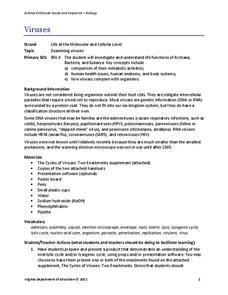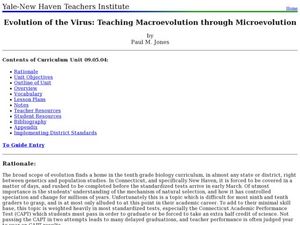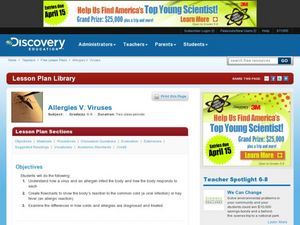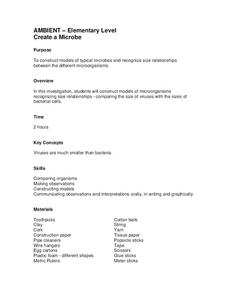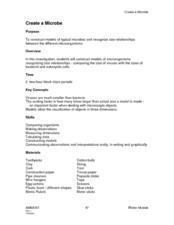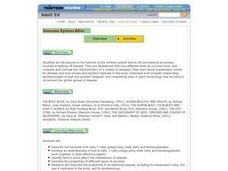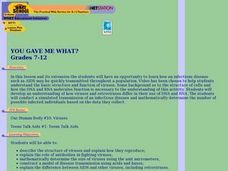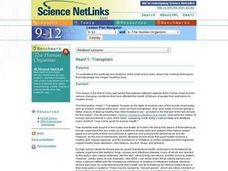Virginia Department of Education
Viruses
Germs, parasites, and viruses, oh my! Facilitate a instructional activity on viruses as individuals explore functions of Archaea, Bacteria, and Eukarya. They learn how viruses compare with other organisms in nature and how they...
Curated OER
NS 6: Monerans, Viruses
Students compare the structures and functions of viruses and bacteria relating their impact on other organisms. They review the main vertebrate groups. Students are describing the characteristics of the main group of vertebrates: ...
Curated OER
Evolution of the Virus: Teaching Macroevolution Through Microevolution
Students describe the anatomy of a virus. In this biology lesson, students compare and contrast the characteristics of bacteria and viruses. They discover the genetic adaptations of viruses over time.
Curated OER
Bioterrorism: Development of a "Superbug"
Students compare bacteria and viruses and their roles in biotechnology and bioterrorism. They outline fundamental steps of bacterial transformation and the possible selection processes to identify transformants. They discuss...
Curated OER
Allergies V. Viruses
Students examine how viruses and allergens affect the body. In this viruses lesson students create flow charts and examine the differences in how colds are diagnosed.
Curated OER
Create a microbe
Students explore viruses and bacteria. They construct three dimensional models of microorganisms recognizing size relationships by comparing the size of viruses with the sizes of bacterial cells.
Curated OER
Create a Microbe
Students construct models of microorganisms recognizing size relationships-comparing the size of viruses with the sizes of bacterial and eukaryotic cells. They put into perspective just how small microbes are by comparing the size of...
Curated OER
Immune System Alive
Students examine the function of the immune system. They read and discuss text, complete a K-W-L chart, sequence photos of white blood cells encountering bacteria, develop an outline, and write an essay.
Curated OER
Smallest Thing
High schoolers compare characteristics of myobacteria and viruses to determine which is the smallest life form. They read and discuss an article that presents different viewpoints on the definition of life to determine their own viewpoint.
Curated OER
Ah Choo!
Students compare bacteria to viruses to find the differences. In this biology lesson, students research viruses they have been inoculated against, using the Internet. Students complete a graphic organizer of their research on common...
Children’s Hospital of Philadelphia
Case Study: The 1918 Influenza Pandemic – Factors Beyond the Biological that Influence the Spread of Disease
A very timely activity looks at the social and political factors that affect the spread of disease. Using the 1918 Influenza Pandemic as a case study, pupils research factors that influenced the spread of the disease, including the role...
Curated OER
TE Lesson: Fighting Back!
Students examine the roles of the immune system in keeping the body healthy. They see how engineers contribute to this process by creating antibiotics, and vaccinations. They discuss how an astronauts' immune system may be suppressed...
Curated OER
An Introduction to Microbes and Microbes Are Everywhere
Seventh graders define the term microbe. They identify the five main groups of microbes. Students give examples of ways in which microbes have impacted or currently impact human life. They create a hypotheses for where they expect to...
Curated OER
Investigating the Method by Which the Body Defends Against Pathogens
Learners explore disease caused by bacteria and viruses, how they are transmitted, and how they exert their effects on their hosts. They explain how diseases, such as AIDS, are spread by exponential growth.
Curated OER
Germs and Preventing Illness: An Inner and Outer
First graders looks at germs through a microscope and identify two that can make us sick. They compare their mouth before and after they brush their teeth and practice proper hand washing techniques. They study the impact of Edward...
Curated OER
Is there a Doctor in the Treehouse?
Young scholars investigate the afflictions of trees and compare the health of a human to that tree. In this tree lesson students complete an activity and create and present a report.
Curated OER
Hazard Mitigation: Bioterrorism
Students discuss different ways to spread infectious diseases. In this bioterrorism lesson plan, students model the rate of smoke emission using CalRoad software. They analyze the effects of airborne release of...
Curated OER
You Gave Me What?
Students see how an infectious disease such as AIDS may be quickly transmitted throughout a population. They conduct a simulated transmission of an infectious disease and mathematically determine the number of possible infected individuals.
Curated OER
Week 3: Pollution Source and Effects
Lab groups set up an experiment to observe what happens over time in collected pond water when fertilizer, representing pollution, is added. This website does not include student lab sheets, but background information, materials, and...
Curated OER
Heart 1: Transplant
High schoolers explain the workings and anatomy of the heart and to explore new medical techniques that help people live longer, healthier lives.
Curated OER
Microscope Investigation
Students explore physical science by participating in a science examination. In this microscope tutorial lesson, students read the book The Naked Eye and discuss the purpose for using a microscope in the field of science. Students...
Curated OER
Immune System Function
Students study the different facets of the Human immune system, including the functions of all the different organs in the immune system.
